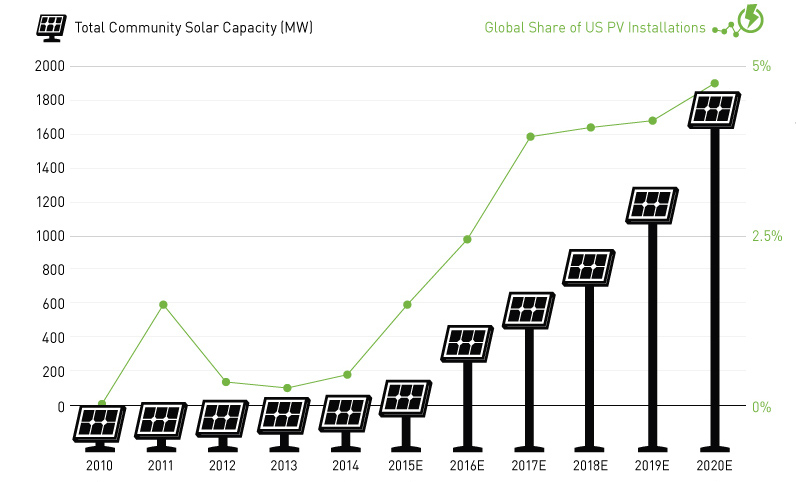Energy
Community Solar Farms Taking Off in 2015 [Chart]
![Community Solar Farms Taking Off in 2015 [Chart]](https://www.visualcapitalist.com/wp-content/uploads/2015/07/community-solar-chart-2015.jpg)
Community Solar Farms Taking Off in 2015 [Chart]
Total installations of community solar farms to jump sevenfold in two years.
The Chart of the Week is a weekly feature in Visual Capitalist on Fridays.
Through the last five years, on average there was only 13 MW of new community solar farm installations per year in the United States market. To put this in perspective, the country as a whole put in 6.2 GW of solar in the year of 2014. This basically gives the “community concept” of solar power the equivalent of a big fat zero on the scoreboard so far.
GTM Research, a division of Greentech Media, anticipates that in 2015 that community solar farms will finally break new ground with 115 MW of new installations, doubling cumulative capacity. Then, over the following five years, a grand total of 1,663 MW of community solar is expected to be installed and operational in the United States with 80% of all installations occurring in California, Colorado, Massachusetts, and Minnesota.
Community solar farms are a concept that tries to address some of the typical drawbacks of rooftop photovoltaic installations. For example, residential rooftop installations must have several factors align for optimal energy production: rooftop size and shape, the microclimate on property, adjacent buildings or trees, aesthetics, building codes, and zoning restrictions must all cooperate.
In community solar farms, people pool their resources together to own panels or a percentage of solar power production at a given location. This concentrates production all in one place where none of the above concerns are an issue, and energy production is maximized. The company or organization operating the solar farm has the expertise to install and maintain panels which also helps optimize results.
Lithium
Ranked: The Top 10 EV Battery Manufacturers in 2023
Asia dominates this ranking of the world’s largest EV battery manufacturers in 2023.

The Top 10 EV Battery Manufacturers in 2023
This was originally posted on our Voronoi app. Download the app for free on iOS or Android and discover incredible data-driven charts from a variety of trusted sources.
Despite efforts from the U.S. and EU to secure local domestic supply, all major EV battery manufacturers remain based in Asia.
In this graphic we rank the top 10 EV battery manufacturers by total battery deployment (measured in megawatt-hours) in 2023. The data is from EV Volumes.
Chinese Dominance
Contemporary Amperex Technology Co. Limited (CATL) has swiftly risen in less than a decade to claim the title of the largest global battery group.
The Chinese company now has a 34% share of the market and supplies batteries to a range of made-in-China vehicles, including the Tesla Model Y, SAIC’s MG4/Mulan, and various Li Auto models.
| Company | Country | 2023 Production (megawatt-hour) | Share of Total Production |
|---|---|---|---|
| CATL | 🇨🇳 China | 242,700 | 34% |
| BYD | 🇨🇳 China | 115,917 | 16% |
| LG Energy Solution | 🇰🇷 Korea | 108,487 | 15% |
| Panasonic | 🇯🇵 Japan | 56,560 | 8% |
| SK On | 🇰🇷 Korea | 40,711 | 6% |
| Samsung SDI | 🇰🇷 Korea | 35,703 | 5% |
| CALB | 🇨🇳 China | 23,493 | 3% |
| Farasis Energy | 🇨🇳 China | 16,527 | 2% |
| Envision AESC | 🇨🇳 China | 8,342 | 1% |
| Sunwoda | 🇨🇳 China | 6,979 | 1% |
| Other | - | 56,040 | 8% |
In 2023, BYD surpassed LG Energy Solution to claim second place. This was driven by demand from its own models and growth in third-party deals, including providing batteries for the made-in-Germany Tesla Model Y, Toyota bZ3, Changan UNI-V, Venucia V-Online, as well as several Haval and FAW models.
The top three battery makers (CATL, BYD, LG) collectively account for two-thirds (66%) of total battery deployment.
Once a leader in the EV battery business, Panasonic now holds the fourth position with an 8% market share, down from 9% last year. With its main client, Tesla, now sourcing batteries from multiple suppliers, the Japanese battery maker seems to be losing its competitive edge in the industry.
Overall, the global EV battery market size is projected to grow from $49 billion in 2022 to $98 billion by 2029, according to Fortune Business Insights.
-

 Money2 weeks ago
Money2 weeks agoWhich States Have the Highest Minimum Wage in America?
-

 Misc1 week ago
Misc1 week agoAirline Incidents: How Do Boeing and Airbus Compare?
-

 Environment1 week ago
Environment1 week agoTop Countries By Forest Growth Since 2001
-

 Economy2 weeks ago
Economy2 weeks agoWhere U.S. Inflation Hit the Hardest in March 2024
-

 Demographics2 weeks ago
Demographics2 weeks agoThe Smallest Gender Wage Gaps in OECD Countries
-

 Markets2 weeks ago
Markets2 weeks agoThe Top 10 States by Real GDP Growth in 2023
-

 Demographics2 weeks ago
Demographics2 weeks agoPopulation Projections: The World’s 6 Largest Countries in 2075
-

 Travel2 weeks ago
Travel2 weeks agoRanked: The World’s Top Flight Routes, by Revenue











